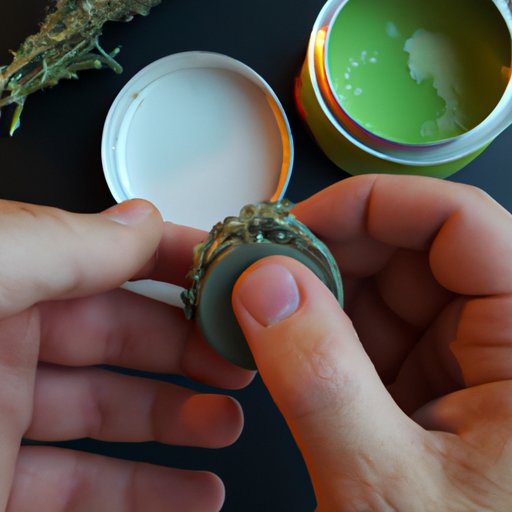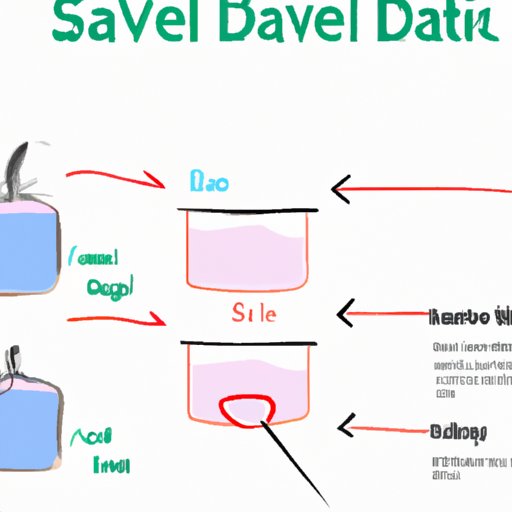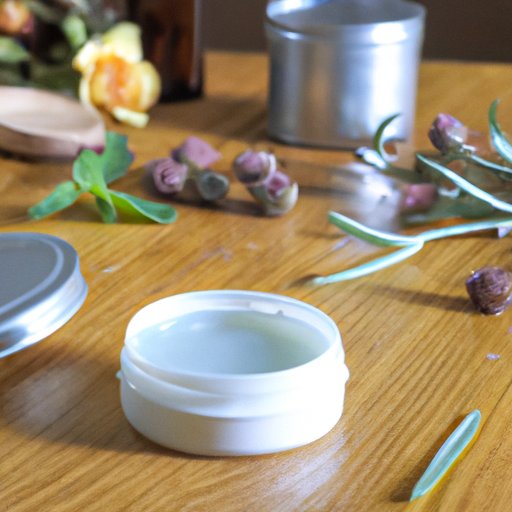Introduction
Draw salve is a type of ointment that has been used for centuries to treat various skin conditions. The name “draw salve” comes from the fact that it was traditionally used to “draw out” foreign objects such as splinters, thorns, and insect bites. Today, it is still used to treat a variety of skin ailments, including cuts, scrapes, burns, rashes, and even acne.
Draw salve is made up of a combination of herbal and mineral ingredients, each of which has its own healing properties. The active ingredients in the salve help to soothe, moisturize, and protect the skin. When applied topically, the salve can work to reduce inflammation, promote healing, and protect against infection.

Exploring the Healing Properties of Draw Salve
Draw salve typically contains a blend of herbs, minerals, and other natural ingredients. These ingredients work together to provide a number of healing benefits. Here are some of the most common ingredients found in draw salve, and the healing properties they provide:
- Beeswax: Beeswax helps to create a barrier on the skin, protecting it from irritants and helping to keep moisture in. It also has anti-inflammatory and antibacterial properties, making it effective in treating wounds and preventing infection.
- Calendula: Calendula is an herb with antiseptic and anti-inflammatory properties. It can help to reduce swelling and redness, while promoting healing and cell regeneration.
- Comfrey: Comfrey is an herb that is often used to speed up the healing process. It contains allantoin, which helps to stimulate new cell growth and repair damaged tissue.
- Glycerin: Glycerin is a humectant, meaning it helps to draw moisture into the skin. It can help to keep the skin hydrated and prevent dryness.
- Tea Tree Oil: Tea tree oil is a natural antiseptic that can help to reduce inflammation and prevent infection. It also has antibacterial and antifungal properties, making it useful for treating a variety of skin conditions.

The Science Behind How Draw Salve Works
The active ingredients in draw salve work in different ways to provide healing benefits. For example, beeswax forms a protective barrier on the skin, while glycerin helps to keep it hydrated. Calendula and comfrey have anti-inflammatory properties that can reduce swelling and redness. Finally, tea tree oil has antiseptic and antibacterial properties that can help to prevent infection.
At the cellular level, draw salve works by stimulating the production of collagen, which is a protein that helps to repair damaged tissue. It also helps to increase blood flow to the affected area, which can help speed up the healing process. By reducing inflammation and promoting healthy cell regeneration, draw salve can help to reduce pain, improve the appearance of scars, and accelerate the healing process.
A Comprehensive Guide to Using Draw Salve
Using draw salve correctly is key to getting the most out of it. Here are some tips for choosing the right type of salve and properly applying it to the affected area:
- Choose the Right Salve: Not all salves are created equal. When choosing a salve, make sure to read the label and choose one that contains the ingredients that will best suit your needs. Be sure to check the expiration date and avoid using salves that are past their prime.
- Clean the Affected Area: Before applying the salve, be sure to clean the affected area thoroughly with warm water and soap. This will help to remove any dirt or debris that could interfere with the healing process.
- Apply the Salve: Once the area is clean, apply a thin layer of salve to the affected area. Gently massage it into the skin until it is fully absorbed. Avoid using too much salve, as this can cause irritation.
- Cover the Area: After applying the salve, cover the area with a clean bandage or gauze pad. This will help to keep the salve in place and prevent it from rubbing off or transferring to other surfaces.
- Repeat As Necessary: Depending on the severity of the condition, you may need to reapply the salve several times a day. Follow the directions on the package for the recommended frequency of application.
How to Treat Skin Conditions with Draw Salve
Draw salve can be used to treat a variety of skin conditions, including cuts, scrapes, burns, rashes, and even acne. Here are some of the most common skin conditions that can be treated with draw salve, and the types of salve that are best for each condition:
- Cuts and Scrapes: For cuts and scrapes, look for a salve that contains calendula, comfrey, and tea tree oil. These ingredients can help to reduce inflammation, prevent infection, and promote healing.
- Burns: For burns, look for a salve that contains glycerin and aloe vera. These ingredients can help to soothe the skin and keep it hydrated, while promoting healing.
- Rashes: For rashes, look for a salve that contains calendula and chamomile. These ingredients can help to reduce inflammation and irritation, while also providing relief from itching.
- Acne: For acne, look for a salve that contains tea tree oil and witch hazel. These ingredients can help to reduce inflammation and prevent bacteria from building up in the pores.
It’s important to note that draw salve should not be used as a substitute for medical care. If you have a serious skin condition, it’s important to seek professional advice and follow any prescribed treatments.

An Overview of Draw Salve and Its Benefits
Draw salve has been used for centuries to treat a variety of skin ailments. It is an effective and safe way to soothe and protect the skin, while promoting healing. Here are some of the advantages of using draw salve:
- Safe and Natural: Draw salve is made from natural ingredients, so it is generally safe to use on all skin types. It is free from harsh chemicals and synthetic fragrances, making it a gentle and non-irritating option for those with sensitive skin.
- Multi-Purpose: Draw salve can be used to treat a wide range of skin conditions, from cuts and scrapes to burns and rashes. It is also effective in treating acne and other types of blemishes.
- Easy to Use: Draw salve is easy to use and can be applied directly to the affected area. It is also portable, so you can take it with you wherever you go.
On the other hand, there are also some disadvantages to using draw salve. For example, it is not always as effective as other topical treatments, such as antibiotics or steroid creams. Additionally, if not used properly, it can cause skin irritation or infection.
What You Need to Know About Draw Salve
Draw salve is generally safe and effective when used as directed. However, there are some precautions to take when using it. Here are some things to keep in mind:
- Read the Label: Always read the label before using any type of salve. Make sure you understand the directions and ingredients, and avoid using salves that contain ingredients that could irritate your skin.
- Test It First: Before using draw salve on a large area of skin, test it on a small patch first. This will help to ensure that you don’t experience any adverse reactions.
- Avoid Eye Contact: Be sure to keep draw salve away from your eyes. If it gets in your eyes, rinse them out with cool water immediately.
- Consult Your Doctor: If you have a serious skin condition, it’s important to seek medical advice before using draw salve. Your doctor can help you determine whether draw salve is the right treatment for you.
Conclusion
Draw salve is an effective and safe way to treat a variety of skin conditions. By understanding the healing properties of the active ingredients, you can choose the right type of salve for your needs. When used correctly, draw salve can provide relief from pain and irritation, while promoting healing and protecting against infection. Just remember to take the necessary precautions when using it.
(Note: Is this article not meeting your expectations? Do you have knowledge or insights to share? Unlock new opportunities and expand your reach by joining our authors team. Click Registration to join us and share your expertise with our readers.)
